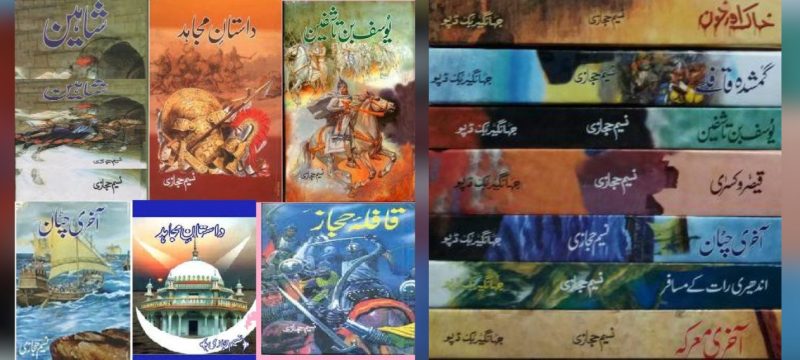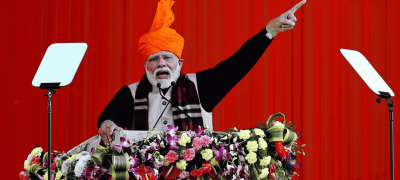After a very long time, I encountered a book by renowned author of historical fiction in Urdu, Nasim Hijazi. It was “Yusuf bin Tashfen”, the first book of Nasim Hijazi I ever read. I wasn’t even ten then but I remember being mesmerized. I remained glued to it until I finished it. Afterwards, I rigorously sought his other books and read them all. I was too young to critically examine and evaluate his work. Now I am old enough, though not necessarily qualified enough, to appraise his work objectively.
Leafing through “Yusuf bin Tashfen” jogged my memory a lot and I remembered the major plot points of all of Nasim Hijazi’s other books as well that I had read and re-read as a child. There is a simple recipe. A country in doldrums, Muslims in grave danger from the state collapse and a determined enemy. Two sets of characters appear on the scene. One set is composed of historical figures while the other is composed of fictional characters whose individual lives are discussed at length. These two sets of characters are further divided into two more sets: good and evil. The “good” are the heroes, who usually win in the end. Even if the book is based on a tragic episode like the fall of Khwarzim and Baghdad, the fictional good characters end up doing well. A minority lives and dies with honor whereas the majority achieves phenomenal success in individual lives in their professional and personal lives. The “bad” are the villains who almost always meet sorry ends. There are two sets of “bad” characters as well. There are the “Muslim traitors” and there are the “non-Muslim tyrants”. Sometimes, Nasim Hijazi very laboriously creates out-of-this-world scenarios to ensure that the villains, especially the traitors, aren’t left with any success or semblance of honor. This visceral wish of his to see traitors getting severely punished shows that he knew the importance of dealing effectively with traitors if any nation is to prosper.
The good historical figures of Hijazi’s books are a fictionalized version of their real/historical selves. They appear perfect and flawless whereas every serious student of history knows that such is never the case. Hijazi did face much criticism on this account as well but in my opinion such criticism is totally off the point. Nasim Hijazi’s historical fiction is meant to depict “what should have been” in the case of the “good” set of characters. Nasim Hijazi’s “good” part of the world is an exercise to imagine idealism. It is meant to induce optimism. For those who don’t agree with his worldview, it can be called “propaganda” or “brainwashing”. This idealism is seen in his fully fictional characters as well. The hero is usually very skilled with both pen and sword. He is also a phenomenal orator. His family is ready to sacrifice everything. His father sheds his blood alongside him and his mother never sheds a tear even when hearing the worst news. Often, she has to raise the family herself and she does so flawlessly and bravely after her husband is killed or imprisoned early on by the forces of evil. The heroine is a similar model woman who is brave, resourceful, sacrificing, and above all extremely understanding and accommodating. The families composed of such model men and women create a powerhouse of Islamic power. These individuals become the right hand of the good historical figures as they vanquish evil.
Now, lets analyze the “bad/evil” part of Hijazi’s equation. In this part, he sheds idealism and even sheds fiction for the most part. I was startled to read the descriptions of the “bad” side again as an adult in “Yusuf bin Tashfen”. They were so accurate that I sometimes felt I was reading about today’s Pakistan. A corrupt elite sucking the people’s blood dry, enslaved by the non-Muslim/enemy foreign powers and in turn enslaving their own people to earn material gains and serve the strategic interests of foreign powers, traitors getting inducted into the elite for their “merit” of selling one’s own nation. The historical accuracy of “bad” characters was as pronounced as the historical inaccuracy of “good” characters. Was it because unlike the good characters, Mr. Hijazi (like us) had the misfortune to observe lots of bad characters in real life? Maybe. Or maybe he didn’t need to fictionalize these bad characters. They were already so grotesque, so predatory, so corrupt, so immoral, and so incompetent that he never felt any reason to tinker with them. After all, even in today’s Pakistan, I can name many men and women who would fit in a Nasim Hijazi’s villain’s character like hand in glove.
It is clear that Nasim Hijazi, like many Muslim intellectuals of that era, yearned deeply for an Islamic renaissance, for a free and powerful Islamic world, for the traitors to get their due, for the good people to live successful lives, and for the bad people to meet horrible ends. He poured all this yearning into his books and envisioned a spectacular Islamic utopia. A utopia that could never be accomplished because in it the forces of evil were completely real while the forces of good were purely imaginary.
Leaving the historical characters aside, where in the whole Islamic world can we find the men and women of Hijazi’s novels who are ready to sacrifice everything including their personal lives, their wealth, their status, their family members, and in the end themselves for an Islamic cause that appears to be fighting impossible odds? In contrast, most of the “good” people I have seen were timid, afraid, ready to mind their own business, and unwilling for any substantial sacrifice. Such “good” people are no match for the real forces of evil composed of unscrupulous traitors occupying positions of authority in Islamic lands and controlled by powerful forces and states of the enemies. Husain Haqqani can easily become the “Ziyad” of “Yusuf bin Tashfen” but I have yet to see a single man who can summon forth 10% of the strength of will and character, bravery, commitment, Islamic fervor, and disregard for personal wellbeing shown by “Saad bin Abdul Munim” of the same book. Thus, the “Hijazian Utopia” remains unfulfilled and the darkness engulfing the Islamic lands keeps on deepening. In this world, the “good” meet horrible ends, the “bad” cruise through life with all they can desire, and the chains of slavery binding the Islamic world grow stronger and stronger!







